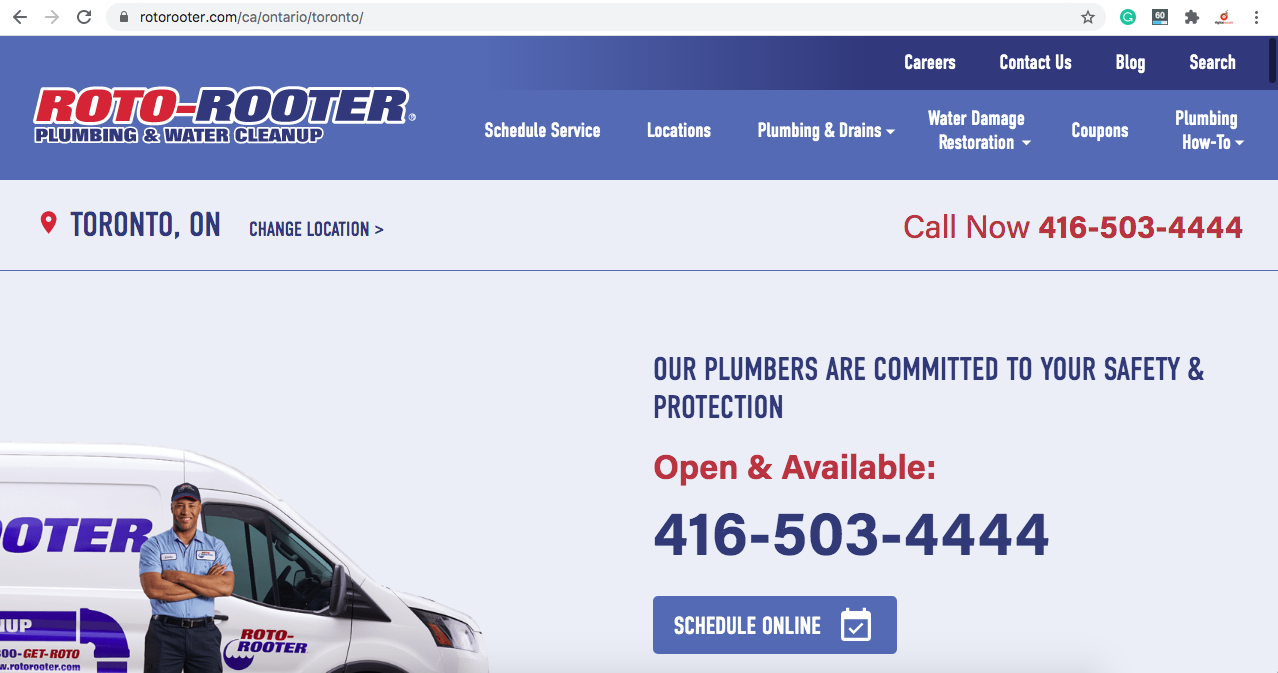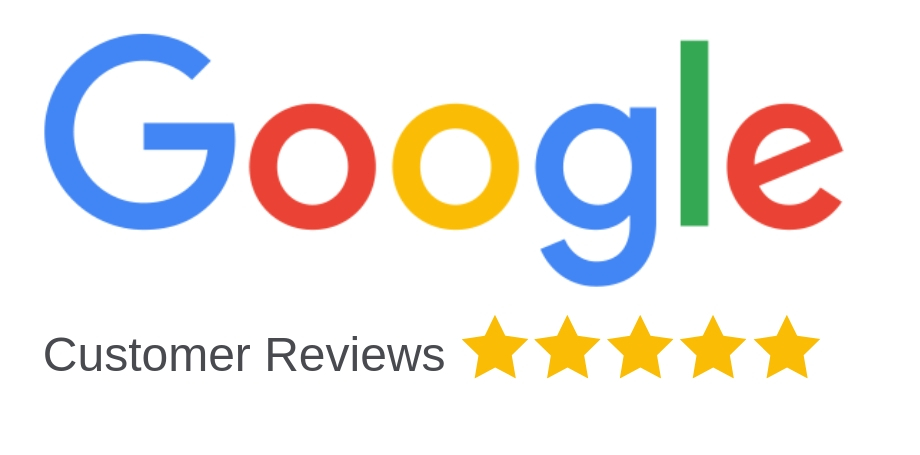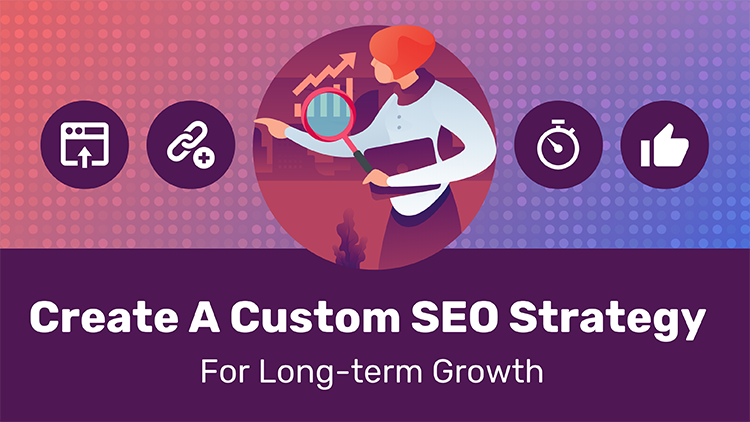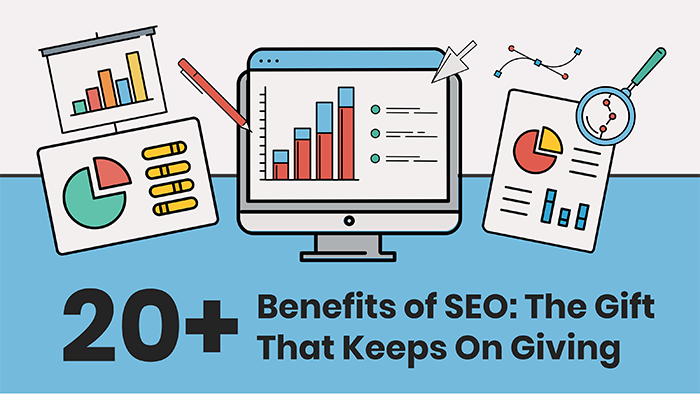Local SEO For Small Businesses [2020 Update]
Generate sales and new clients within your city with local SEO for small businesses. We live in an age where digital marketing is a massive source for driving new business. More than 90% of people will use their phones to research and make a purchase. Capitalize on the power of local SEO for small businesses and dominate the search engine results in your city.
Local SEO for small businesses is not just about ranking on Google. Although Google controls most of the search engine market, there are still many other ways people search for local businesses such as Yelp, Bing, Yahoo!, etc. For this reason, this article will mainly focus on ranking on Google, but also on using alternative ways to supplement your streams of traffic.
This guide will take you on a step-by-step tutorial on how to get your business up to speed as well as how to compete and outperform your competition in the localized search results.
Google My Business Setup
Setting up your GMB account is fairly straightforward. You’ll need a Google My Business account so head over to Google My Business to get the process started.
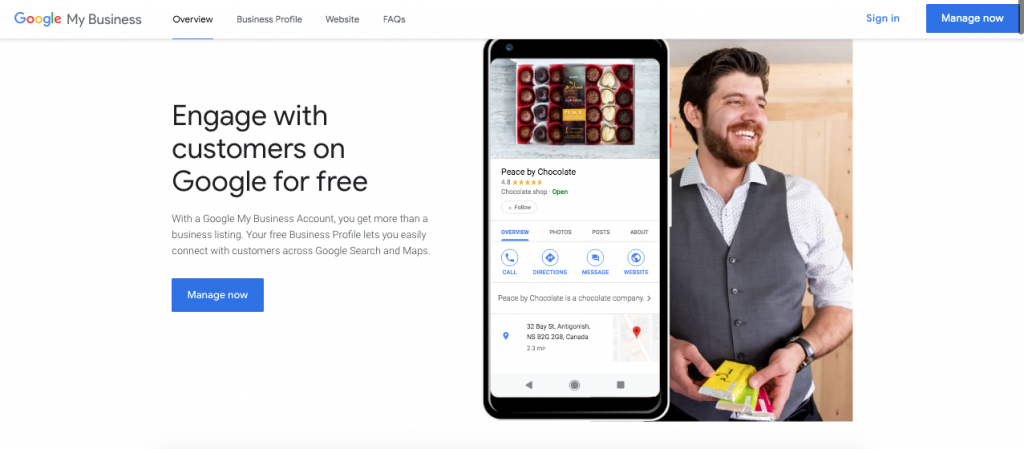
You’ll be walked through a series of steps to create your profile with all of your business information. Although you can always switch the primary category you initially select, you should know that choosing the most appropriate category can greatly affect your search visibility. If you choose the wrong category, Google may not associate your business with relevant keyword searches.
You can confirm you’re in the correct category by searching Google for your keywords and then scanning the competing GMB listings to see what category they’ve selected. If you see a lot of your competitors with the same category, it’s a safe bet that’s the same one you should be choosing.
For example, if you’re a landscaping company, you have a few options to choose from such as Landscaper, Landscaping design and Landscaping architect. Make sure the category you choose puts you in competition with companies that offer similar services.
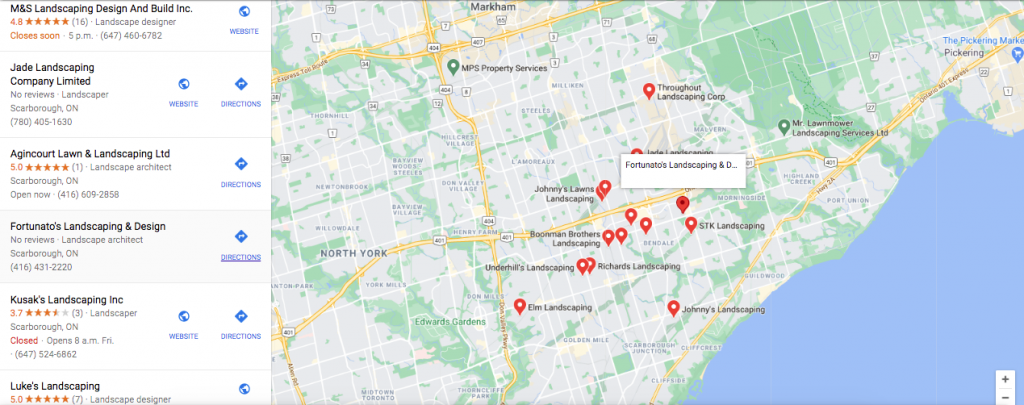
In order to make any changes or additions to your profile, you’ll need to verify your listing which is done via phone call or postcard.
When entering the address for your business make sure you submit the actual business address of your company. You may need to move the marker on the map if Google got it worng-so double check just to be sure.
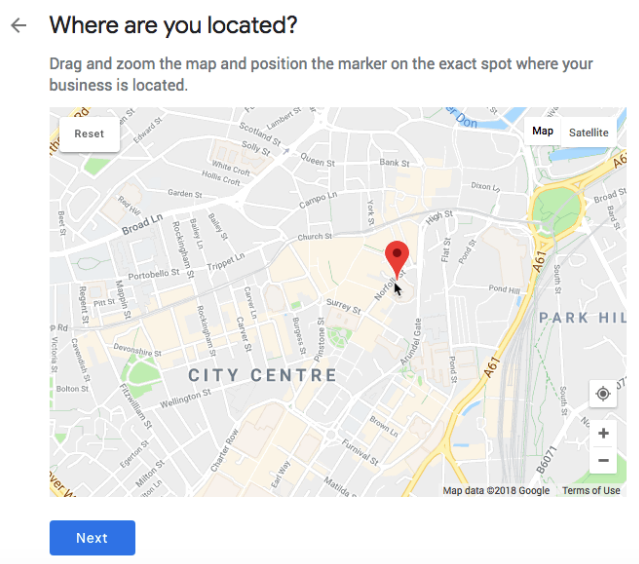
If you’re a service area business, you can use your home address. Just select the option that indicates you deliver to your customers.

If you don’t offer services at your home and therefore don’t want your home address displayed, there is a button you can select that will hide your address and display your service areas.

If you happen to have partners in your business or have multiple physical addresses, choose the one that’s closest to the centre of your target city. This will promote more appearances by being centred in a more densely populated area-even if you’re selecting a service area business.
Optimize your account
Optimizing your account is as simple as filling in every field that you can possibly provide information. When a search is made on Google, the information from your GMB profile is pulled to associate your company with keyword related searches.
Make the effort to include as much information as possible to give your website the most opportunities to appear in localized search results.
Upload photos to GMB
This may seem like an unimportant aspect of building your profile, yet it’s one of the most viewed components when customers are researching your company. Include as many images of the interior and exterior of your place of business.
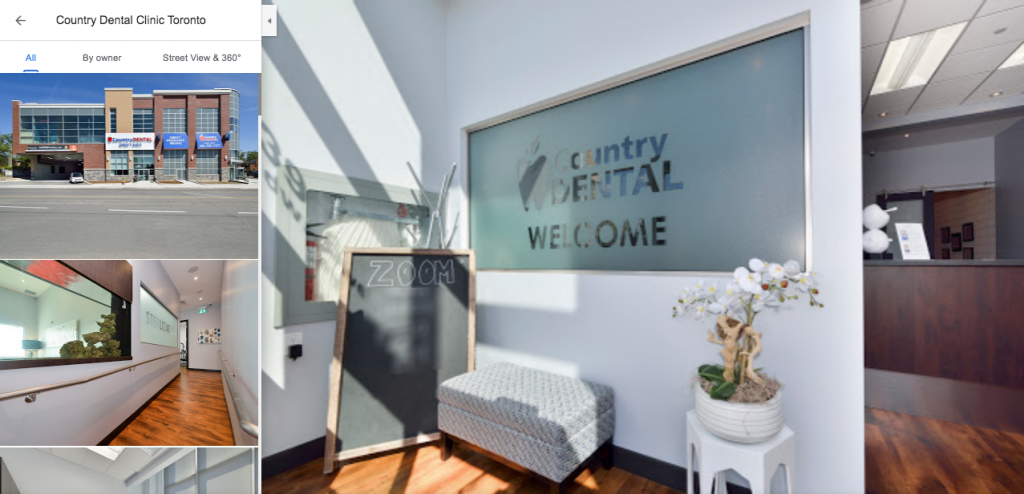
Upload product images or examples of work you’ve performed to give your potential clients a sneak peek at what your company offers.
Publish microposts
There is a small correlation between staying active on Google posts and driving more traffic. Although posting regularly may not improve your actual ranking in the local finder, it does help to take up more real estate in the search results.
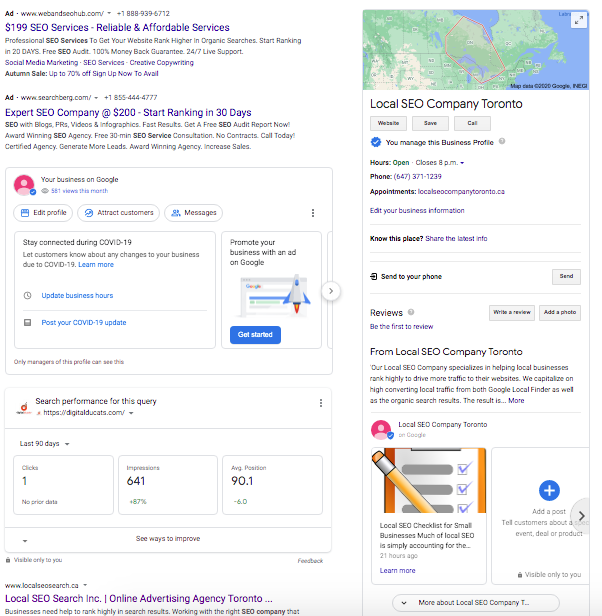
Increase the click-through rate to your website by publishing microposts to your profile on a weekly basis. A high res image and catchy title will help to improve your CTR.
Bing Places For Business
When you’ve verified your profile on Google, claim your business on Bing places for business. Bing’s search engine only accounts for less than 10% of all local searches in Canada, but why not welcome the additional traffic to your website?
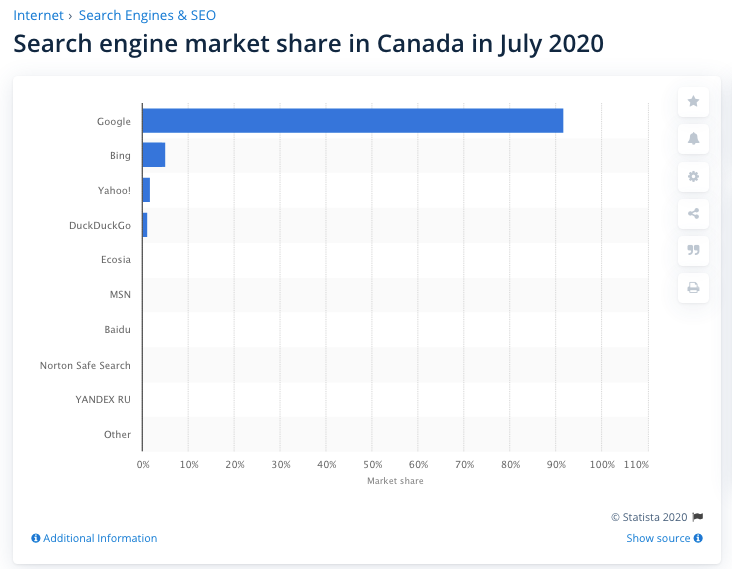
Once you’ve begun the process of claiming your business, Bing will search for your business to see if a listing already exists. If you don’t see your business listing you can go ahead with creating a new profile.
You’ll be given the option to import data from GMB. This will save you time in creating your profile and ensure your profile information remains consistent (no typos). Choose the option to have your data imported and sync your accounts.
Apple Maps
Think about how many iPhones are in circulation. Apple sold over 40 million iPhones in Q1 of 2020. Although most people may prefer to use Google Maps, Apple Mpas is the default system for providing directions whenever you ask Siri. There should be no doubt about it, listing your business in Apple Maps will result in additional traffic to your website.
There are millions of searches that are being made through the Apple Map platform, so why not capitalize on the searches that are being made in your city? You’ll need an Apple ID to register your business.
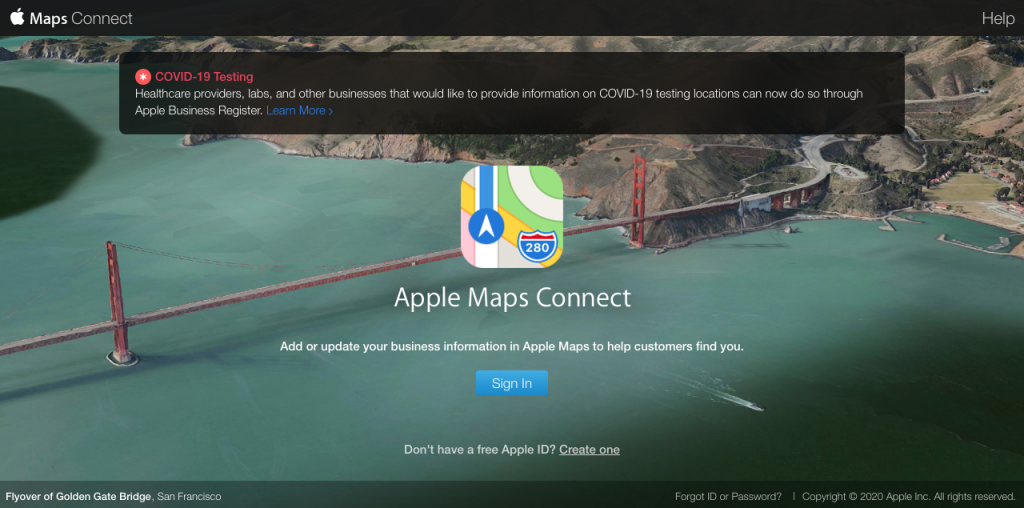
Structured citations
A structured citation is an instance of your business details being posted to a website. It is considered structured if there are specified fields to enter your name address and phone number (and website). Directory listings, profile links, review websites are examples of where you can find structured citations.
Listing your business in directories has a twofold effect on your website:
- Structured citations strengthen your position on Google’s Local Pack/Finder.
- Directories provide relevant local referral traffic.
Structured citations confirm your NAP details (name address and phone number). Google verifies the validity of your NAP details with credible citations, and as a result, your search presence in the Local Finder/Local Pack improves.
Choose major citation websites as well as niche-specific and location-specific to create a positive ranking signal for your website in city-specific searches.
Major citation websites
Major citations for your industry and country can be found on Whitespark.ca You don’t need to add them all at once. In fact, it may be better to limit yourself to adding 10-15 a month.
Niche-specific citations
Identify a minimum of 3 niche-specific directories to enlist your business as a start. You can use a simple Google search to find the most relevant directories. A popular search would be:
[your keyword] + business directories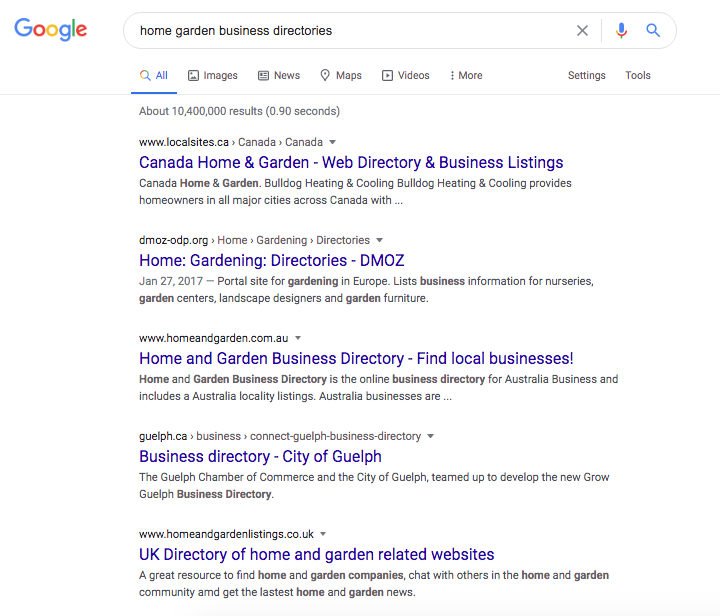
The results may not be within your location, however, the search should uncover some of the larger niche directories in your industry. Choose three to start and perform your next search for local directories.
Location-specific directories
Search for the most popular city-specific directories with a simple Google search:
[your city] + business directoriesPRO TIP: Download the Mozbar browser extension to filter out the low-quality websites along with those that are heavily spammed. The Mozbar will indicate the domain authority (DA) which you should keep at a minimum of 15 DA at the lowest. Spam scores are naturally high for directories so you may need to concede in this area.
Here’s a search for Toronto business directories in which the result are displayed with the Mozbar:
At a glance, you can see that only the first and third results would qualify as citation prospects. The second search result shows a DA of only 14 (The PA is the page authority).
Some directories you will need to pay to join. These are probably good directories for your website but you don’t need to pay to get what you need from structured citations. Avoid it if you’re on a tight budget.
The second qualifying metric you want to double-check is the amount of organic traffic that flows through the directory. If a directory gets little to no organic traffic, it’s a red flag. You don’t want your website to link from graveyards or heavily spammed sites and organic traffic can tell you whether you’ll get some referral traffic on top of the citation.
There are many analytic tools you can use, but SEMRush offers a free version that gives you the numbers you need. Plug in the URL of the website and the overview will display the approximate organic traffic the website receives.
This value indicates whether the website ranks organically for keywords and does in fact drive traffic that can be beneficial to your website FYI, the above directory would be a terrible directory to list your Toronto business.
On-page optimization
The optimization of your pages is crucial to appearing for city-specific searches. Create a strong competitive advantage by making sure your keyword is included in your metadata as well as within your content.
Local SEO keyword strategy isn’t extremely complicated as it’s basically [your product or service] + [your city], and similar variations. If someone needs a plumber in Toronto, they’re going to type “plumber Toronto” or “plumber in Toronto” or “Toronto plumber.”
If your business services one city, optimize your homepage to appear for your product/service plus your city.
How to optimize your homepage
Make sure the most important pages are a click away for users landing on your homepage. Include a navigation bar that hosts the service and product pages that you want people to easily find. Highlight your most important products with blog posts that feature related content (preferably geared towards converting visitors to clients)
Include the NAP details (Name address and phone number) in the footer so the company address is present on every page of the website. Embed a Google map so users are able to click on the map for directions to your storefront.
If you operate a service area business then you may want to create location pages to give your website the most competitive advantage in appearing for each of the cities you service.
Location pages
Your company should have a separate page for every city you provide service in-especially if you have multiple physical locations. Each location page should be published with unique content. Never duplicate the same pages while only changing the city.
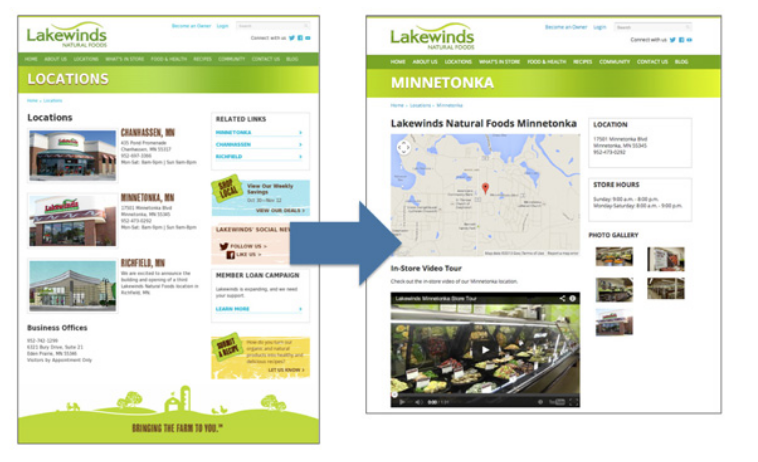
A good location page will reference the city with landmarks or any unique identifying content that can be associated with that area. Include the address, phone number and a map of each location to create more local relevance and a stronger position in the search results.
A location page gives you the opportunity to include the keywords in the most important places such as the URL, title and meta description. This enhances on-page optimization which is a large factor for ranking local websites in localized search results.
Local content
Location pages are considered local content, but apart from your location page, you should be publishing regular content about your business and city. Here are a few examples of the types of content you can produce that positively impact your local search visibility.
Client surveys
You can survey your clients on just about anything related to your product or service. One of the major benefits of surveying your clients is identifying their personal preferences, like dislikes or even just getting their opinions about a particular issue.
Knowing the preferences of your clients are a huge asset to providing an exceptionally high level of customer service. You can cater to the needs of your more closely and discover areas that may be hurting your business.
Additionally, a survey will contribute to creating high quality content based on the results. You clients would be absolutely interested in the experience of fellow clients using your product or service.
Expert roundup
An expert roundup is another way to bring more attention to your company while building local alliances. If you’re strategic with your content you can get a lot of companies that aren’t direct competitors, but operate within your field of expertise to participate in a roundup.
This could be an expert opinion that you collect from each of a number of businesses on a trending topic. An on-site example of this can be seen in the infographic we designed titled, “12 Web Design Trends For 2020 By Toronto Experts”.
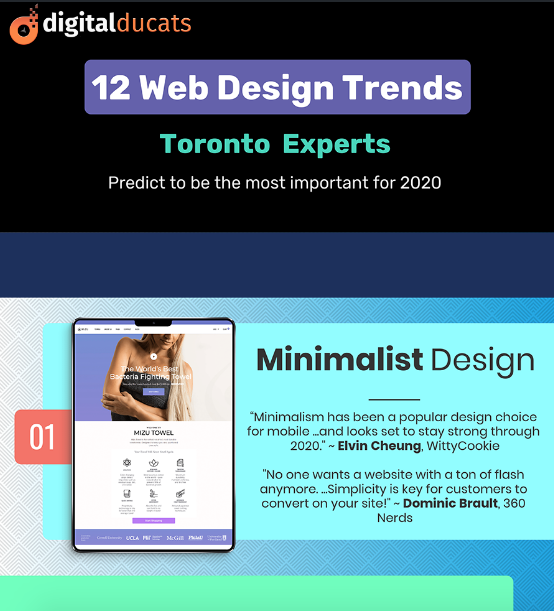
As an all SEO company in Toronto, we are closely aligned with web design companies, however, we don’t offer the same services. In this expert roundup, we gathered the opinions of 18 different web design companies on what each expert was the most important web design trend in 2020. We then designed an infographic with an answer from every expert.
The infographic was not only shared by many of the experts who participated but attracted a large number of backlinks.
Local events
Whenever there’s a local event worth mentioning, post it on your blog. The publication of local activities in your city creates strong ties to your locality. Be sure to include the relevant NAP details and link out to the local sites that are involved in the event.
Host a local event
If your company is hosting the event be sure to post the details on social media, local event websites and community bulletins. Get the word out to as many local people as possible to promote your business and create a few more backlinks to your website.
Post details on Eventbrite.ca if it’s large enough. You can also use Meetup.com if or a similar site if you’re holding regular meetings. Keep in mind that meetings don’t have to be in person. Virtual events are also fair game and equally worth writing about.
Sponsor a local event
You don’t need to hold an even all on your own. You can also look for events that are related to your area of expertise and apply to sponsor the event. Again, Meetup.com is a great site to use for finding events to sponsor, but you’re not limited to Meetp.com as there are a bunch of similar sites to choose from.
To find what events are looking for sponsors type in this search operator into Google:
site:meetup.com + inurl:sponsor

The search results should be a list of pages that have the word sponsor in the URL. Here is an example of a sponsor page for a Toronto group:
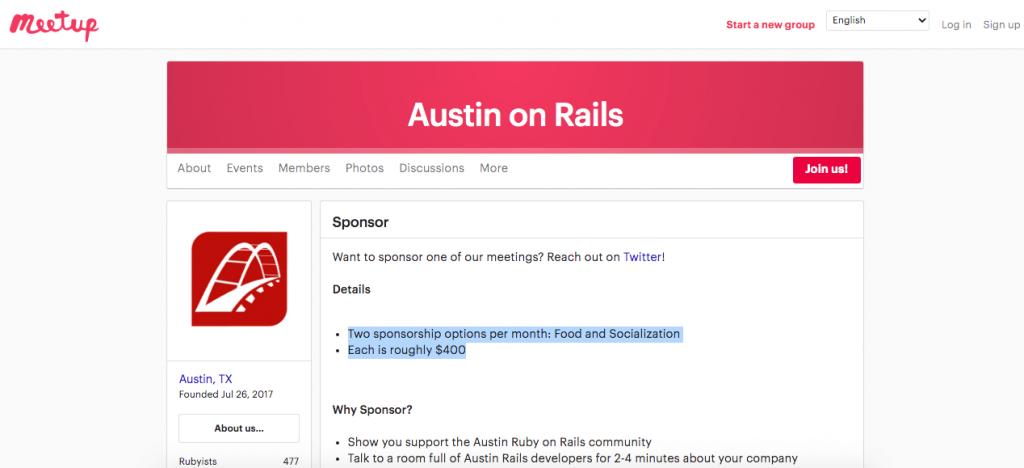
Choose events that are worth talking about on your blog. Although the bonus to sponsoring an event is you get a backlink to your site you still want there to be a strong relationship between the content of the meeting and your business..
Unstructured citations
When your website’s NAP details appear on a website that isn’t formatted specifically for listing company info, it’s considered an unstructured citation. This can be any one of the NAP details as seen here in the Kingstonist magazine for the Integrated Care Hub. This particular citation includes the name and address.
This does provide value however, obtaining a link from an unstructured citation is the most valuable of local backlinks.
Unstructured citations are found in local news websites, local business websites and local blog sites. These links are considered la crème de la crème of backlinks and will have the greatest positive impact on search visibility as far as quality backlinks go.
Publish local content to attract unstructured citations
Publishing local content will contribute to obtaining unstructured citations. For example, in your expert roundup you may be able to get a few businesses to link to your site within their content.
Asking for a link is a much easier discussion with a website owner when the link you’re asking for points to an article that they’re featured in on your site.
Gain citations from local news sites
If your business is involved in activities that give back to the community, it might qualify as newsworthy content. For any charitable activities your company might be involved in, you can send a few local reporters a news tip on what your business is doing and see if there are any bites.
Local journalists will typically write about any community news as long as it’s not overly promotional and there’s something worth telling the community about.
Local blog site citations
There is a ton of people blogging in your area-unless of course you live in the North Pole. Find bloggers interested in talking about products, services or topic-worthy issues associated with your business.
If your business is in garden maintenance, find which blogs would publish a few amazing tips that no one heard of before. Many bloggers/influencers accept products in exchange for a review, mention or a link back to your website. Contact influencers and bloggers whose audience is the right fit for your business and they have a substantial following.
Maximize revenue with a local SEO strategy
There are a lot of moving parts to create an effective local SEO strategy, but the rewards are well worth the investment.
Remember that although Google may account for the bulk of the local traffic you receive, there are many other ways to add valuable streams of visitors to your website. Make use of all the options available to create high volumes of relevant local traffic to your site.
SEO Case Study: 200% Traffic Growth In 4 Months
There’s nothing like good, hard evidence of how SEO provides a return on your investment. The following is an SEO case study on a local home goods supplier in which we achieved an increase in traffic of over 200% in just four months’ time.

A brief history of the clients’ website
The company sells patio furniture, hot tubs, barbeques, billiard tables and more. The client began services with Digital Ducats after working with an SEO Toronto company for almost 5 years.
Their website had a number of backlinks and they had published content on their blog continuously during the last four years.
After a website assessment, it was determined that although they were ranking for some keywords, many of their pages were lacking on-page optimization. Most of their blog content was low-quality and not good enough to rank on the first page of Google.
The Google My Business profile was loosely put together and was lacking optimization wihch was resulting in low search visibilty in Google’s Local Finder.
The main objective
The ultimate goal for this SEO case study was to push the websites ranking up to the first page of search results. We wanted to create a stronger search presence for the keywords that would drive the most potential clients.
The objective was to increase revenue using a content-driven strategy. The goal was to build awareness and drive traffic using keywords to rank for content that satisfied users at the informational/research stage as well as the buyer stage.
The SEO strategy explained
A competitive analysis was performed on the top ranking websites in the niche. In order to create a more competitive website, we needed to establish how the competition had achieved its top ranking in terms of content, site structure, link building strategy and optimization.
The results of our keyword research provided the basis for the content that needed to be published to drive traffic with buyer potential. A content audit was performed to identify the pages that could be enhanced to rank higher.
The SEO campaign included:
On-page optimization
- Meta tag optimization
- Titles
- URL structural analysis
- Internal link strategy
- Topical organization
- H tags
- Canonical references
- Outbound links
- Schema
- Structured data markup
- HTML code cleanup
- SERP feature optimization
- Page speed optimization
- Mobile optimization
- 301 redirections
- 404 Error corrections
- Robots.txt review
- Sitemap creation and submission
- Install Google analytics
- Set up Google Search Console
- Google My Business Optimization
Backlink strategy
When we first began work for the client, the backlink strategy was already mainly composed of directory links and citations. We started with:
- Toxic link removal
- Niche and local citations
- Links from niche blog sites
- High authority links from appropriately themed websites
SEO Case Study results
In between the third and fourth months, the traffic for our client had nearly doubled in multiple categories when compared to the same months from the previous year.
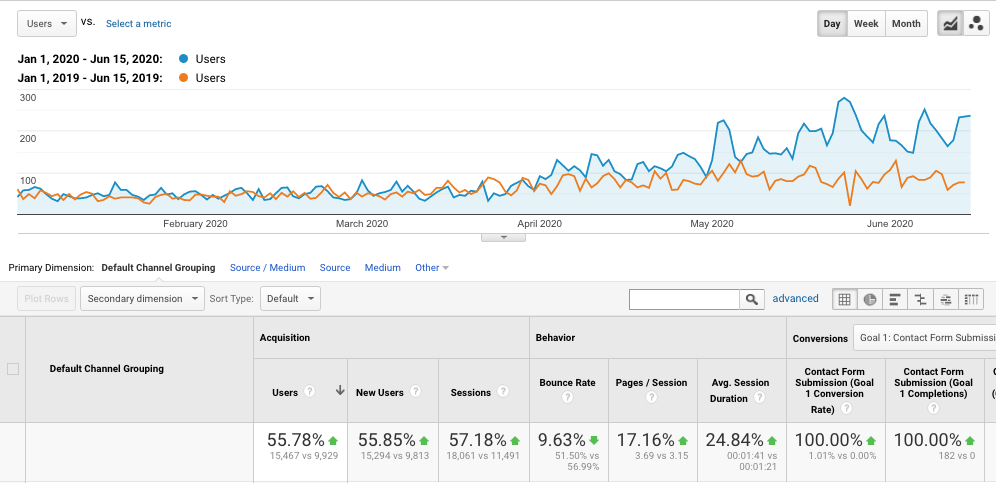
The number of keywords that our client ranked for went from 300 to 700 and we improved our client’s position on the first page for multiple search terms.
Organic traffic was literally doubled when compared to the same time period the previous year. The website had received 7744 visitors in the previous period which has increased to 13,521 visitors

Although the results for this client only took 4 months, it should be noted that the expected time to see the full results lies somewhere between the six to nine months range.
Digital Ducats Inc. is one of the best choices you can make for your business when it comes to investing in a marketing strategy that produces results.
Claim & Optimize Your Business Listing On Bing Maps
Appearing in a local pack or local map listing on any search engine can be one of your greatest sources for high converting leads. Claim and optimize your business listing on Bing Maps in order to maximize your search presence, improve your local SEO and drive more high-converting traffic to your site.
People who are searching for local businesses are typically looking to make a purchase in the near future. Believe it or not, people actually use Bing and Yahoo to search for stuff!
Despite Google’s domination in the search engine market, Bing still carries a percentage of searches that are valuable to every business. In March of 2019, approximately 6 billion searches a month were made on Bing, which currently holds approximately 33% of the desktop searches in the US.
What’s more, is that Bing is a major directory that Google uses to confirm the authority and credibility of your business’s NAP details. The name, address and phone number should be consistent across the board. Every directory and review site should have correct and up to date NAP details to avoid confusion from users looking for your business.
If you haven’t claimed your Bing business profile, doing so will help you manage the information to better match your Google My Business profile and every other citation built on your company.
Here is a step-by-step guide on how to claim your listing and create a stronger local presence by completing and optimizing your profile.
How to claim your listing on Bing Places for business
Go to Bing Places to get started.
Since you’ve never used Bing before you’re going to select New User.
The next screen you’re faced with a decision. To either import your business from Google My Business or start new.
By opting to import your GMB profile
You will already have many of the fields filled out for you. This eliminates the possibility of making any typos when you’re completing your profile.
This also saves you time.
This also gives Bing the power to read and edit your data on GMB. Despite the ominous gift of power you’re donating, it’s reasonable to import your data and avoid the extra headache.
If you use this option you don’t need to go through the entire verification process.
By opting to claim or add your business manually
To claim and optimize your business listing on Bing, you’ll need to go through some additional steps to get your business listed with the correct details.
Apart from filling in your company details, the main time-consuming factor is the time it takes to verify your information to make your profile live on Bing.
How to add your Bing listing manually
If you opt to add manually, the first question you’ll need to answer is about the type of business you’re adding. Enter the appropriate answer from the drop-down menu.
Make sure the country is correct in the next box and you will be prompted to search for your business.
This is to see whether a profile has already been created. Enter your business name and the zip/postal code or city and state/province in which your business is located.
If you see your company name in the list of options that are presented, click on it to edit the profile.
If your company is not in the list of options, scroll all the way to the bottom and select the box that says My business is not listed in the search results.
A box will immediately appear for you to modify your search or to create a new business.
If you’ve spelled your company name correctly and it hasn’t appeared, select create a new business.
You will be asked to log in using one of the following platforms:
It doesn’t matter what you select, but if you want to sync profiles or manage multiple profiles, choose the platform that you use the most (if you have a GMB profile it would make sense to use the same account).
Optimize your Bing Places profile
You will be brought to your first screen, which should be fairly straightforward to fill out as it is all basic company information.
If you don’t have a location where you serve clients (you operate in service areas eg. Locksmith) there is an option to select. However, you will still need to enter an address where you receive mail to verify your business.
The next screen will dive a little deeper into how Bing identifies your company. You will be asked to select your segment of business.
Choose the most appropriate segment that best represents your business. These are the main groupings in which you will further define in your next selection for your main category.
After choosing your segment, choose your primary category in order to optimize your business listing on Bing.
Getting these categorizations correct is extremely important in order for the search engines to properly place your website in keyword-related searches.
If you don’t see the main category of your business, you may not be in the right segment.
For example, if you chose Business-To-Business as a segment-you wouldn’t find website design in the next dropdown to select the primary category.
You would need to go back and choose Professionals & Services as your segment in order for Website design to appear in the Primary Category dropdown.
If there is any uncertainty about what your category is, do a Bing search for businesses like yours. You can check how they’ve categorized their profile from the local listings themselves.
Once you’ve moved on to the next screen you’ll have the option of listing your address publicly or privately. If you don’t have customers visit your business address click the option to hide this address in the search results.
Fill in your contact details. The more information you provide the better.
Add images to your profile. This may seem optional but images can have a big impact on how prospective clients view your business. Adding images will help to give your company more credibility and instil stronger feelings of trust.
Add your business hours. If you type in the times for Monday before you open any other days, they will all open at the same time you typed into Monday’s slot. This saves you a bit of time searching the drop down for each day.
Make sure your hours are the same on your website, GMB profile and any other citation you’ve built with the operational hours of your business.
Click Submit to complete the last section for optimizing you profile.
Verify your business on Bing Maps
Choose the method of verification that works best for you. You can elect to have a postcard sent to your address or can download the Bing Places App and verify over the phone.
The postcard can take as long as two weeks to get to your address.
Downloading the app is significantly faster since your listing can be approved in only two days.
Note: If you’re using a computer-generated number to verify your business through the app-it won’t work. You need an authentic landline or cell phone number to get the phone call from Bing.
If you’ve entered a legitimate cell phone number or landline, a machine will call and give you a confirmation code to enter in order to verify your listing. You can also opt for an SMS text message.
Once verified there you will be one more review of your business before it become official. You will be notified by email (or App) when you’re business listing is officially live and on display.
Encourage reviews and keep your NAP details up to date. Bing Places is a major directory that feeds a number of other data aggregators. Incorrect information on your Bing profile will ultimately filter through to other sites.
Keeping your data synced with Google My Business on a weekly basis ensures the two biggest local directories are kept consistent.
Remember that despite the paltry 2.5% of the world search engine market that Bing holds, much of the market share comes from the United States. That makes Bing one of the few companies that resemble being a competitor of Google’s.
Be sure to claim and optimize your business listing on Bing Maps and reap the rewards of high-converting local traffic to your site, or have one of our SEO consultants do it for you.
Local SEO For Dentists: A Guide To Client Acquisition
The significance of local SEO for dentists has continued to grow in the dental industry ever since Google became the new Yellow Pages. Google processes more than 3.5 billion searches each day and approximately 46% of all searches are made with the intent of obtaining local information.
When people want to find a local dentist, 87% of people will search on Google. Local searches are one of the highest converting sources of traffic. According to Google itself, 72% of people will reach out to a local business within 5 miles of their location after finding them in a search.
Whether you’re starting your first practice or you want to accelerate the number of clients that find you on Google, defining a local SEO strategy for your dental practice will increase the volume of traffic through improved search visibility.
Drive traffic with Google My Business
One of the first areas that should be addressed is your Google My Business profile. Consider this an extension of your website that is eligible for a top position in Google’s Local Finder.
Only the top three businesses will be listed on the first page, however, getting your practice on the map and in front of an audience will start to get your website noticed. In order to move your listing to the first page into what’s called the “Local Pack”, you’ll need to follow a series of steps to make your profile more competitive.
How to optimize your GMB profile
Go to Google My Business to set up an account. You may be asked to enter your company name to make sure a listing doesn’t already exist.
The next step is to choose the primary category to enlist your practice. This is an extremely important step for driving traffic that best fits your business so read all of your options.
You can always change your primary category so don’t feel like it’s a final decision. One way to confirm you’ve chosen the right category is to search for one of your keywords and see what category your competition is using.
The next steps should be self-explanatory. If you don’t have a website you can choose to “create a free website” for the time being and add the URL of your website at a later time.
List every service your practice offers. Include every procedure and everything you charge your clients to make your page eligible to show up in keyword searches.
Publish a professional and keyword-rich business description
Create a keyword-rich description that your prospective clients will read when they view your business. This is your message to people who are looking for your services so make sure you’re thorough, warm and welcoming and have described the range of services available.
Add interior, exterior and relevant images
Upload as many images of your practice as possible. You can do this anytime but keep in mind you’re much more likely to convert visitors when they get a sense of who you are and the environment you’re working in.
GMB photos get a lot of views-especially the interior of dental offices. People want to see where they’re going. Use high-quality images that show the best aspects of your office.
There is a separate field to upload your logo.
Go to the info tab and add to every field that you’re able to provide information. A complete listing has much more information to connect you to potential searches from users.
You will need to verify your listing before any of your information becomes available to the public. Your listing will only be visible to you until you enter the verification code received on the Google postcard (sent within 12 days).
Building structured citations
In order to confirm the validity of your business information, you use citations on a variety of different websites. Structured Citations are considered review websites and directory listings because they offer a specific place to enter your business information.
Listing accurate NAP details are vital in establishing the credibility of your businesses’ local presence. Your name, address and phone number need to be consistent in every instance it appears online.
List your business on alternative search engines
Create profiles on the major search engines that offer local business listings. Duplicate your GMB profile information exactly as it is displayed on Bing Places for Business and Yahoo! Small Business (in the US).
You can import the information from your GMB directly into your Bing account. This can save you loads of time and will eliminate the possibility of typos. Learn how to claim and optimize your Bing places for business profile.
List your business on keyword related directories
You can search for directories that are directly related to your niche by using your keyword in a search. Check the first five pages of search results to see which directories appear.
Directories that appear in a keyword search are potential sources of traffic since users may be clicking on them to find more options for dentists. Here the first and second results for the term dentist in Toronto happens to be directories.
Apart from adding an additional position in which your website can be found, a directory that appears in a keyword search is also an indication of the relevance the directory has in the niche.
Not only will appearing in the directory provide additional traffic, but acquiring a backlink the directory will improve the local authority your website has in localized search results.
List your business on local directories
Search for local directories by searching [your city] business directories. Google will display a list of city-specific directories that are unique to your location.
List your business on major directories
Yellow pages are one of the top directories that feed into many smaller directories in Canada and in the US. Listing your business here is automatic because of the volume of traffic it receives as well as the fact it gets your info into multiple directories.
Every country has a different set of directories that will play a larger role in your optimization. Identify the top tier of directories to build profiles of your practice.
Choose three websites from each type of directory to give your company a diverse profile. Many of these directories will link back to your site to give it a good start in building a local backlink profile.
Be extremely cautious listing your website on directories you haven’t heard of that look spammy (filled with ads). If you list your website on directories with low authority and low traffic, you will end up hurting your site more than helping it.
You can check the quality of a website by using SEMRush (no account needed). Simply enter the URL in question and look at the traffic the site receives. Low traffic will indicate that the site will not help you receive any benefits from being listed on it.
Review management
Part of managing a local SEO strategy for dentists is creating a review strategy. Reviews are believed to contribute to your local business ranking. In fact, in the State Of Local SEO Industry Report 2020, 90% of marketers believed reviews impact your website’s presence in the local pack.
In a poll that surveyed 1000 marketing professionals, Google reviews scored a second place in most important ranking factors for localized search results.
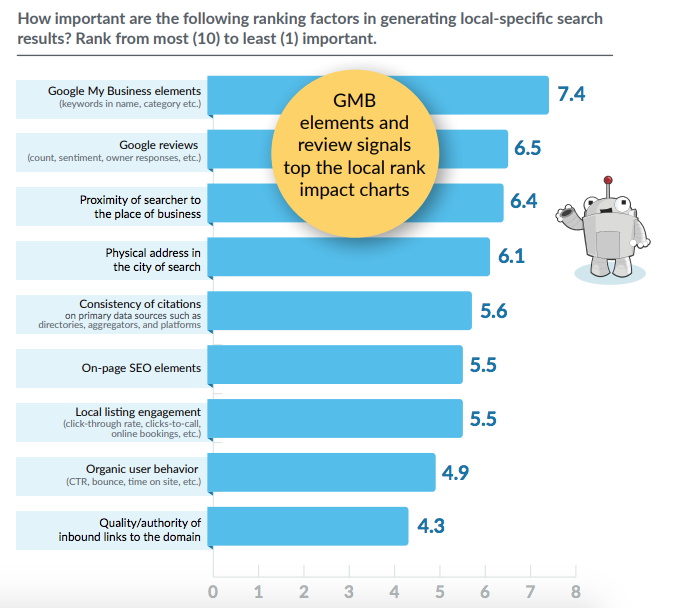
Put a review strategy in place so that you can keep reviews continuously coming in on a steady basis. It should be obvious that you need to acquire Google reviews, however, a good cross-section from other relevant review sites can also have a big impact on your local presence.
How to encourage more reviews
In order to encourage receiving the highest reviews, make sure you only ask people that are extremely satisfied with your work. A personal request goes a long way, however, people don’t always remember when they get home, so you may need a backup plan.
Include the request for a review on the receipt or in a thank you email after you’ve completed any particular service. Embed a link in your email with written instructions to simplify the process and serve as a reminder to your clients.
Respond to positive and negative reviews
If you’ve asked for a review and received one, thank your client. There is a way to do this on every platform and a simple expression of gratitude will go a long way. When other clients see your responses, it can be more encouraging for them to leave a review as well.
Negative reviews are bound to happen. Be sure to respond in a timely manner in order to show your best customer service. Publicly offering to correct a mistake or misunderstanding shows people you’re willing to go the extra mile to make your clients happy.
It also puts another spin on the situation apart from the disgruntled clients. Train your receptionists to include asking clients if they’re happy with the service. Having a system where reviews continually roll in is a great way to strengthen your local presence.
How to choose the best keywords for your practice
In order to drive the highest converting traffic, you’ll need to identify the keywords that suit your practice best. List the main services that you want your practice to be known for to create the major pillars of your site.
Using a keyword tool you can confirm the number of searches and the level of competition that each keyword possesses in order to finalize your decision. Here you can see the keyword root canal is a level 57 difficulty.

If your city us super competitive you may need to add a geo modifier in your title and URL to make your page hyper-local. By adding Toronto as the geo-modifier, this reduces the competition considerably.
Keyword tools can also give you insight into different ways to target the service that you’re offering. There is a list of options that are generated as suggestions to your keyword that you can use as alternatives or incorporate into your content to enhance the optimization of the page.
Choose the keywords that offer the highest volume of traffic with the lowest competition. Whenever you consider pursuing a target phrase always use it a Google search yourself to see what results are displayed. You want to confirm that you’ve assumed the correct search intent that the keyword suggests.
For example, you should expect to see other dentist websites appear in a keyword search you’re considering to target. Anything other than your competition may suggest that the users are not looking to hire a dentist, but gather information or satisfy a different form of search intent.
Implement a content strategy that builds awareness and educates
A major part of driving traffic to your website is publishing content that is popularly being searched. SEO for dentists is not just about being found for one keyword, but also involves creating awareness and nurturing leads to build trust and confidence in your practice.
For example, someone who is nervous about getting a cavity filled may be searching Google for answers to questions they have about the experience. Creating a blog that answers these questions increases the number of visitors on your site.
This approach to answering commonly asked questions not only goes a long way with potential clients but is also rewarded by search engines. Using a topical content structure to build on the depth of your services is a powerful way to drive more traffic from Google.
For every service you have, there are different stages people go through before committing to a dentist. These stages can be categorized as awareness, consideration and decision.
Some people may not know why they’re feeling pain when they bite into a pineapple. Your blog can address the potential causes of tooth sensitivity, cavities and provide the options for a solution.
For many new patients, the information provided on your blog is the help they needed to overcome something minor. When something becomes more serious, they are now thinking of your website as a source for dental services from the awareness previously built.
Educating your clients is a crucial part of the SEO cycle that drives more traffic by creating awareness, educating and building trust in your dental practice.
Publish location pages to expand your business
Location pages create a local presence in neighbouring towns and cities. For instance, if you’re in Toronto but would like your practice to appear in Mississauga, a Mississauga location page would be a solution to appear in search results specifically for that city.
Location pages allow your business to expand beyond the limits of your own city. Localized search results are largely influenced by on-page optimization and a local backlink profile.
Although you may not show up in the local pack without a physical address, an optimized location page can get your website to appear in the organic results in any city you target.
Publish local content
Use your blog to publish city-specific content as it relates to your business. Creating content about your city creates strong ties to your locality and will contribute to local rankings.
An example could be keeping updates on the various stages of recovery your city is experiencing that has resulted from COVID-19. Relating this to your business operations and how it affects the residents of your city contributes to positive local optimization signals.
On-page optimization
Every page on your website should target a specific keyword. In order to give your page the best chance at appearing for your keyword, you should ensure it is placed in all the right places. Use a plugin such as Yoast to make things easier by alerting you if any of the major on-page optimization attributes are missing.
Here are a few of the main aspects of on-page optimization:
Use a keyword-optimized title with H1 tags
Your H1 tag should contain your keyword because it describes to search engines the most important content on the page. Most content management systems will tag the title of your page with h1 tags automatically.
Your title is one of the most important parts of your page because it’s what appears in search results. Be sure to include your keyword in the front end of your title to ensure it’s not cut off or truncated on smaller sized screens.
Write a compelling meta description
Your meta description is another crucial part of advertising your page in the search results. The description you use should create an interest in clicking through to your page.
Write your meta descriptions using keyword-rich descriptions. The use of keywords communicates to the user that they have found what they’re looking for and promotes a higher click-through rate.
Again, keep your target keyword near the front end of your description.
Use your keyword a few times within your content
In order to show that your page is highly related to your target keyword, it should appear in your copy at least a few times. There’s no need to repeat your keyword more times than that since it won’t make your page any more optimized. In fact, unnatural use of your keyword or excessive repetition may result in adverse results to your search visibility.
Use your keyword in the first 100 words or first paragraph whenever possible.
Optimize your images
Save your images using your keyword in the filename. If you have multiple images, don’t overdo it, simply use keyword synonyms.
The alternative description (or alt tags) tell search engines and the visually impaired what your image is about. Use your keyword and keyword variations with the alt tags of images you post. In this example of an image in WordPress, you can see the keyword improve on-page SEO highlighted in the area assigned for the alt tag.
Use the correct dimensions for the images you post. If you have images that are 2000+ pixels, the chances are you won’t need an image that large. Reduce the file size to exactly what is required on your site will increase your page speed from reduced server requests and a smaller file.
If you’re using WordPress, install a plugin called Smush to compress your images. You can also implement “lazy loading” which delays images beneath the fold from loading until you scroll down towards them resulting in faster page speed.
Interlink your content
Using internal links can enhance the optimization of every page on your site. When you have a page that references the content on another page, you can use an anchor text link to connect the pages.
The text you use to link the pages should be descriptive in order to increase a search engine’s understanding of the content on your page. Use both optimized and un-optimized anchor text to interlink content on your website.
Building authority, credibility and ultimately ranking ability
If you’re no stranger to SEO for dentists, you might already understand the significance of building backlinks to your website. In order to build authority and credibility, your website needs “referrals” or “votes of confidence” from other websites. These come in the form of backlinks.
The main concept that ties ranking in with a strong backlink profile is that other websites find your content so valuable that it’s worth sharing with a link.
In order to get the most from your backlinks, you need to focus on getting links that improve your credibility in your expertise, and in your locality. Acquiring backlinks from local sites in or related to your industry are considered the most powerful types of links.
Leverage the power of unstructured citations
An unstructured citation is an instance of your name, address or phone number being posted to another website-even though there is no set place for it to be listed.
For example, a directory listing is a structured citation because there are specific places to enter your information. A blog post that mentions the name of your practice is unstructured because the name of your company is used contextually within the content of a page.
List your professional resources for unstructured citations
Write a list of twenty people that you know have websites and are related to the dental industry. Ask the following questions:
- Who do you order supplies from?
- What companies do you work with?
- What other dentists may support you with a link from their website?
Exhaust your network for likely candidates because the people who already know you are most likely to link to your site.
Search Google or link opportunities
Another method of identifying links is to search Google using specific command operatives such as inurl.
You can look for sites that offer resource links and guest posting opportunities by telling Google to search for websites with a keyword in their URL.
For example, the command teeth whitening + inurl:links displays the following websites with pages that link out to other websites:
Join a professional association
You can also become a member of professional associations. These sites will often link back to your site with a highly relevant backlink. Here’s an example of a profile from the Dental Industry Association Of Canada:
One practice that requires a bit of caution but is highly effective, is spying on your competitor’s backlink profiles. Enter the URL of a top-ranking website into an analytic tool like Moz to get a glimpse at the websites that are linking to the top websites ranking for your keywords.
Keep in mind that although you may find a lot of backlinks that point to a top URL, not all of them will be good for your site. In fact, some of those links may not be good for your competition either.
Make your decision based on relevance to your niche, city and whether the site gets a decent volume of traffic. You don’t want to go through the effort of getting a link on a graveyard site because Google won’t give you too much credit for those anyway.
Tracking and monitoring your progress
In order to adapt and grow, create measurable goals for your website. This cannot be achieved without tracking the performance of your website on a monthly basis. Two of the most powerful tools you’ll need also happen to be free of cost.
Make use of webmaster tools using Google search console
Just as you would open the hood of your car to see the engine, you open Google search console to see what’s going on with your website. Search console tracks the performance of your site as well as alerts you to any problems that it may be experiencing.
Familiarize yourself with the performance tab functions to see what pages are ranking. You can see your top-performing pages, how many times they appeared in searches and how many clicks they received.
You can also monitor any errors that are being generated from your site that might affect page ranking.
Google analytics
Although Google search console can show you a lot of information, you need Google Analytics for more specific details in reporting. Here you can customize reports, set goals and monitor goal conversions.
An example of a goal conversion could be to get visitors to make a call or book an appointment. You can set this up in Analytics by going to Admin, Goals, New Goal.
You can also see how your users are navigating your site.
There are also comparative reports you can run to see whether your website is generating more traffic at any given block of time. You can compare previous years, previous months or any specific periods of time.
Tracking results is your only way of knowing whether your SEO efforts are paying off. Despite the advanced capabilities of Search Console and Analytics, if you’re interested in tracking your website’s rankings, you’ll need a separate rank tracking software such as Moz, Ahrefs, SEMRush, Rank Tracker, etc.
Capitalize on Local SEO for dentists and increase your revenue
Defining a local SEO strategy for your dental practice is one of the wisest decisions you can make for our business. SEO is one of the few marketing strategies that is growing in popularity and will only get more competitive as time passes.
Take control of your companies growth by implementing the practices outlined in our guide. Build a local presence for your dental practice to guarantee the long-lasting success and growth of your business.
Will Toronto’s Stage 3 Delay Help Or Hurt Your Business?
Toronto- On July 25, 2020, Premier Doug Ford Toronto’s stage 3 delay due to the fact that public health officials requested more time to analyze data. This has officially delayed Toronto’s move to Stage 3 of the COVID-19 reopening plan Ontario has laid out for most of the province.
Windsor and Peele join Toronto’s Stage 3 delay in the plan for the gradual and safe reopening of in-person businesses. This may damper the outlook on the immediate economic recovery but this doesn’t change what Toronto companies should be doing now to promote the growth of their business.
Capitalize on the growing demand for online transactions
If there is one key takeaway from this unprecedented experience, it’s that contactless service is now a valuable asset to have in your business.
Companies need the ability to offer goods and services online and promote contactless operational methods. Precautions need to be made to reduce the transmission of deadly diseases that rear their ugly head now and in the future.
For brick and mortar business that may mean shifting as many products as your company offers online. Companies that were able to adjust and adapt to the quarantine restrictions were also able to realize above average results in sales.
Companies that couldn’t find the right solution have suffered, and many have closed their doors permanently.
Adapt to accelerating trends
The future of the way we do business was already trending towards an increasingly digital environment. E-commerce has been on the rise and the importance of search engine optimization in periods of quarantine has increased profits for niche retailers such as Wayfair.
Wayfair reported increased profits of over 40% during the pandemic. Prior to quarantine, this retailer was struggling to turn a profit.
Wayfair’s results are a testament to the rapidly changing behavioural patterns that consumers have demonstrated amidst the crisis. More people are more willing to seek and use online solutions.
Local SEO has taken on a new level of importance as more customers find local Toronto companies through their cell phones, voice search or a Google search. In order to maximize revenue, there needs to be a local search presence for keywords that are vital to your business.
Consult with an SEO company
For most businesses now is the best time to invest in SEO services in Toronto. Unless you truly believe that the world is ending, then you have to accept that there will be an economic recovery.
The best time to get in on a stock is before the climb upwards. Investing in your website’s SEO now will give your business a huge competitive advantage six to nine months down the line when demand starts to accelerate.
Give your Toronto business a headstart
SEO takes time for a website to experience the full effects of traffic generation and lead conversions. Now would be the time to improve the search visibility of your company. Position your website to receive as many visitors as possible when the economy starts to move.
Regardless of the recovery get your website moving in the right direction by developing it to generate more leads and new clients. A number of industries have already experienced a surge in traffic from increased online searches.
Many retailers are struggling to keep up with the demand.
If this isn’t the story for your company, make it your story by speaking with an SEO consultant and learn how we can help your business increase revenue. Use Toronto’s stage 3 delay in reopening to your advantage by capitalizing on increased online demand.
What Is A Location Page And How Do I Publish One?
A location page is a location-specific page that ranks in a city, state, province or country that is built specifically for the location you target. Location pages are used to improve your local presence in another location.
If your business is capable of providing service to multiple areas (service area business or multi-location), this is an excellent method of creating a local presence in the city you’re targeting.
Let’s say, for example, you’re a mobile mechanic. You have a garage located in Scarborough ON, however, you’re able to service the Greater Toronto Area.
Rather than optimize for searches just within Scarborough, you can build a location page to target searches for Toronto, or any other city surrounding Toronto as well.
Here is an example of a mobile mechanic location page for Toronto.
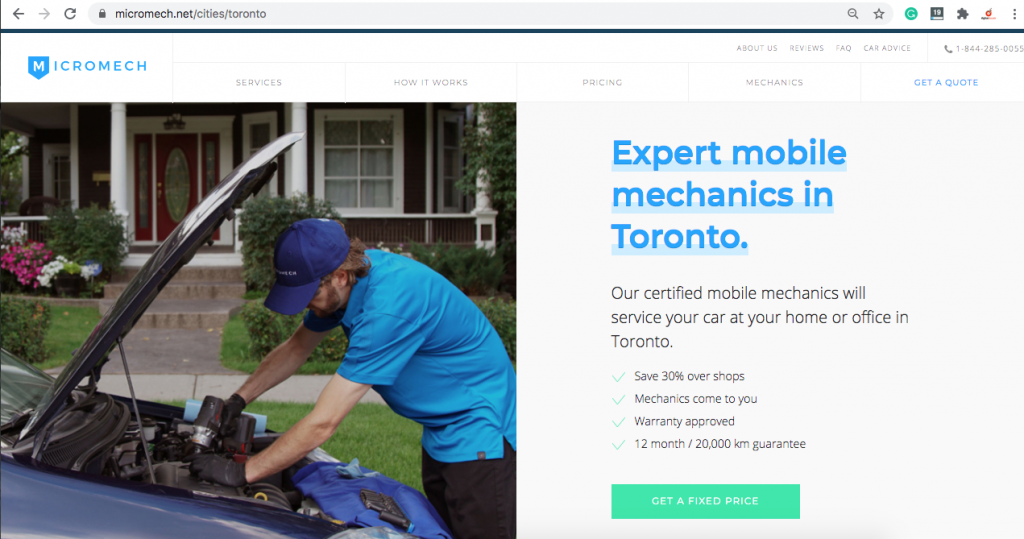
Here is another page on the same site for Calgary.
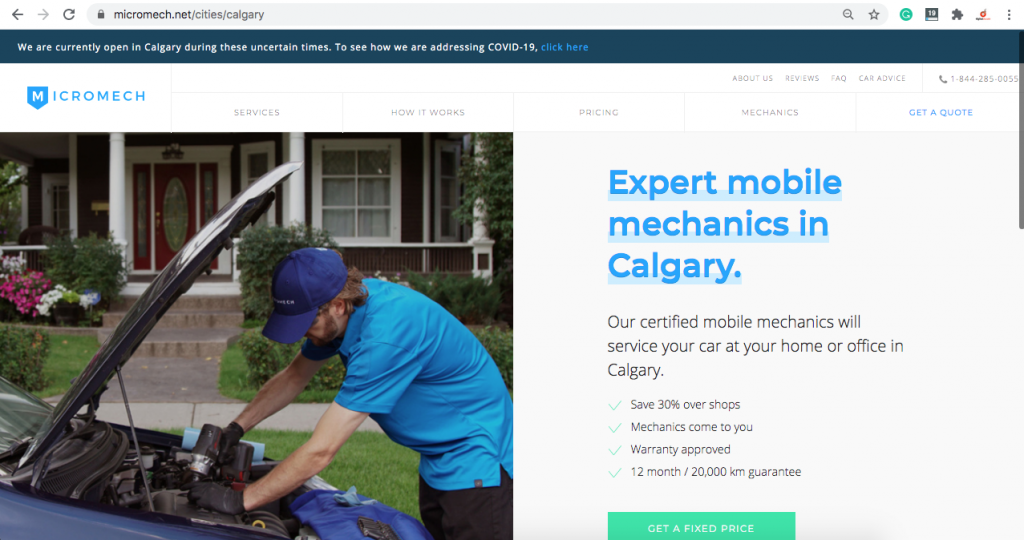
This company is taking advantage of ranking in multiple cities to expand the areas in which they can do business. Here is a look at the service areas this busienss covers:
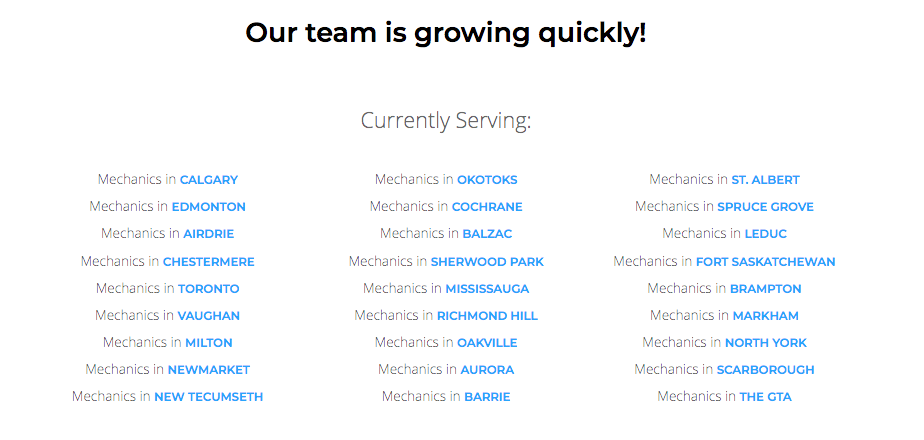
Whenever a user in another city searches for your service, your location page will have a much better chance of ranking on the first page.
Location pages are an aspect of local search engine optimization to expand your company’s reach and increase the revenue your business makes.
Why be tied down to one location if your company is capable of doing more business in more cities? It’s a similar concept to setting up franchise locations except your using web properties to stake your claim in other cities.
9 tips for publishing location pages
Location pages share similar characteristics that allow them to rank highly. To see your location page rise in the search results, address the following areas:
Target the most effective keyword
It’s impossible to optimize a page without doing any research on the keyword you’re targeting. Keyword research provides insight into the value of your target phrase and the level of competition you will be facing.
If you’re going to go through the trouble of ranking a location page, make sure it’s worth it. Your target phrase should drive enough relevant traffic to generate revenue. Choose the best keywords to target by going through the proper steps for keyword selection.
Identify and satisfy the intent of the search
Establish the true intent of the search phrase to understand the type of traffic that is driven to your site. Keyword research helps to establish what visitors are looking for when they type in a particular search phrase. When your page satisfies the intent of the search there’s a better chance of ranking highly in the search results.
Are the pages that currently rank for your keyword informational, transactional, navigational or commercial?
The chances are most location pages will need to include a bit of everything. To completely take your prospects from and introduction to conversion, requires careful content planning.
Each competing page that ranks is major clues to how search intent is begin defined by search engines. This typically is a direct correlation to what users are looking for as well.
Optimize your page in all the right places
Optimize your page to target a specific search term that includes the city you’re targeting. Include the target keyword in the page title, URL and a few times within the content. Any images should have the keyword and keyword variations in their alt tags.
This is the bare minimum for basic on-page optimization, however, it goes a long way in local SEO. You can enhance your on-page SEO a number of ways but using the basics is a must for every location page.
Make your page hyper-local
Make your page hyper-local to the target city. If you can mention landmarks, or make city-specific references, it will tie your page to the locality. Link out to local sites and resources. Prove to search engines that you’re familiar with the area and cater to local residents.
Post name, address and phone number on your page
If your company has a physical location within the city, post the NAP details on the location page.
For service area businesses, a unique phone number with the city area code will help to optimize your page.
Use structured data markup
Use structured data markup wherever possible to help search engines better understand your page. This will also make your page more attractive to users and entice more clicks if you can generate rich results.
FAQ structured data markup is an example of a rich result. This snippet gets users to understand more about your business directly from the SERP. The extra space your search listing takes up attracts more attention and pushes your competition down the page.
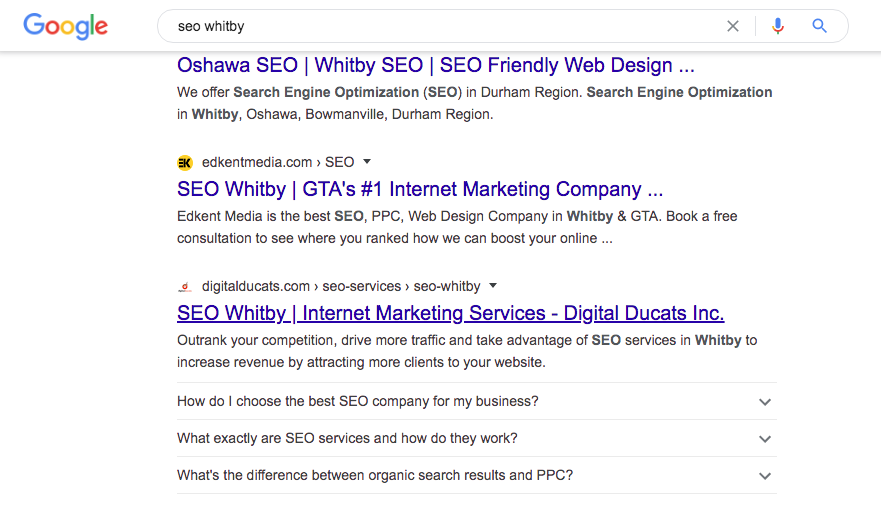
This type of rich results allows you to link to interior pages of your site. Help people to better understand what you can do for them with your product or service.
Reviews are another major type of rich result that is insanely popular.

Structured data markup makes your search listing more attractive with rich snippets. Although Schema.org has over 800 different categories to use, Google only offers about 30 types of rich results.
Implement structured data markup to increase the click-through rate and drive more traffic to your site.
Use an internal linking strategy
The linking strategy you use to build the authority of your page begins internally. Use descriptive anchor text and link from related pages to your location page. This builds the profile and authority of your location page.
In the same respect, link from your location page to relevant pages on your site. The links should help your visitors understand what your business offers.
This linking structure forms a basic topic cluster and highlights your location page as a pillar within your site. This linking structure will contribute to a more authoritative location page.
Build external links carefully
Use extreme caution when building the ranking ability of your location page with external links.
SEO best practices are to build links as natural as possible. Any unnatural link building patterns will be ignored and possibly have adverse results on your location page.
For example, it’s common for local businesses to have backlink profiles mainly comprised of directories and review sites. Local links will have the greatest impact on your location page.
You can indirectly link to your location page by linking to blog posts that in turn link to your location page. The link equity is transferred as a second-tier link. This builds more overall authority to your site and helps power the authority of your location page.
Publish local content
The content you publish on your blog has a large impact on how your site is viewed in a specific city. Search engines will take city-specific posts into consideration when they assess your site. Create blog posts that have very location-specific references to create more relevance in the city you’re targeting.
Link your city-specific blog posts to your location pages to include them in your topic cluster. This ensures that search engines connect your local SEO content to your location page.
Use location pages to build an empire
The beauty of creating an effective location page is that your business is able to expand the market in which it competes. You’re company is essentially setting up a new branch in another city by creating a page that ranks for your keywords.
When growth is your goal, create location pages to increase the traffic your site generates with visitors from different cities and locations.
Local SEO Content: Improve Your Local Presence
Want to rank for searches within a specific city? The solution is simple; Be city-specific with the content you publish. Local SEO content is an excellent way to get search engines to recognize the city in which you want to improve your local search presence.
What is local SEO content?
Local SEO content is content that is optimized for a city-specific keyword. The content within your page will identify unique elements that relate the content to a specific city.
By identifying popular landmarks, places, addresses or anything unique to the locality, your page and your website become more closely associated with searches that originate from your target location.
There are a few different types of content that work well to optimize for your city, county, state or province. Here are seven of the more popular types that you’re most likely to see used on a website.
Expert round up from professionals in your city
An expert roundup is a form of evergreen content where you combine the quotes from a group of professionals. Confining the area in which you collect your quotes will make your content local to your city.
You can generate a lot of good local backlinks from different local experts that will in turn boost the competitive ability of your website within your city. People will link to your content when they are featured in it.
This type of content can be combined with an infographic to really improve the likelihood of your project being shared within your industry. An example of this is 12 Web Design Trends In 2020 By Toronto Experts.
In this example, 18 experts shared their opinions on the top web design trends for 2020. The infographic was shared and used on a few of the participant’s sites, which accounted for a boost in local traffic.
You can read the details in a local SEO strategy case study.
Local client surveys
Create a survey for your clients that will help you understand how to serve them better as well as create extremely targeted content. Original data is one of the most valuable assets you can obtain in terms of content creation. Focus your survey on your local clientele to create highly optimized content.
One of the benefits of generating your own data is that you can promote your content to other companies in your niche. When you have something no one else it becomes a linkable asset. Other websites will be much more likely to use your data as a resource when the information is coming straight from your own research.
Host a local event
If you’re planning on hosting an event, no matter how small or large, you should be writing about it on your blog. Include the name, address and times of the event and use structured data mark up on your page.
Hosting your own local event creates an opportunity to publish highly optimized content to your city. As search engines index your site, the amount of local content you’ve published contributes to a stronger local presence.
Sponsor a local event
If your business covers service areas or you simply don’t have the resources to host an event, there are plenty of opportunities to sponsor a local event.
Simply getting a link to your website on the sites that are promoting the local event is worth the local optimization points. These events should take place in the city you’re optimizing for and you can write about the event on your blog to promote awareness.
Here’s an example of a Meetup group in Toronto that has six sponsors listed on their Meetup page.
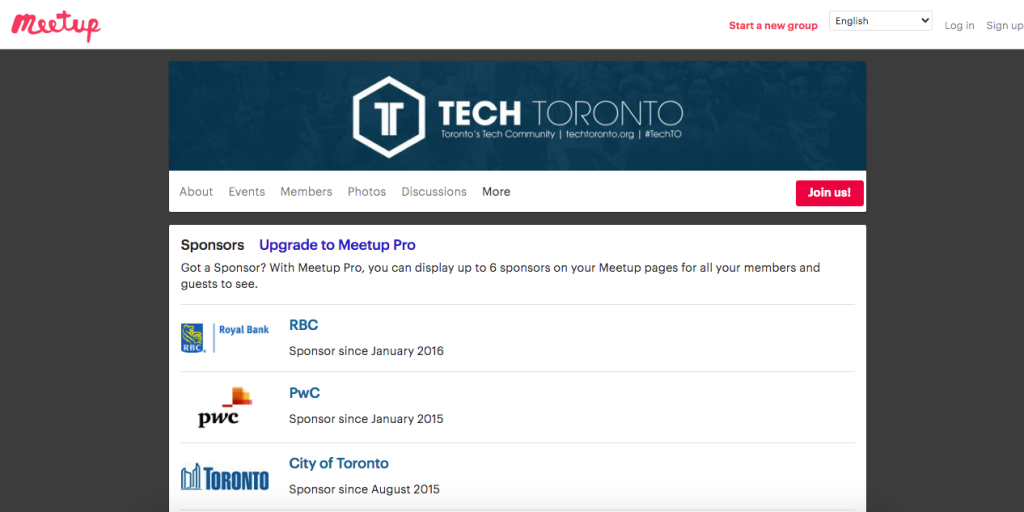
You can look for opportunities to sponsor events on sites like Meetup, Eventbrite and your local chamber of commerce.
Location pages
If your website operates in multiple locations, a location page for that city will give you the best opportunity to rank highly for city-specific search terms.
Location pages can be optimized to provide more relevance to the target location. With a page dedicated to a specific city, you can optimize for the city in the metadata as well as include city-specific references within your content.
Here’s an example of the Toronto location page for Roto-Rooter. You can see the URL includes the province and city. The title (h1 tag) is also Toronto, On.

If you have an address located within that city, your NAP details should be included in your on-page optimization. Including structured data mark up will ensure search engines know your page is dedicated to a specific city.
Write about local events and activities
Publish content on local events and activities that relate to your business. Give your audience updates on current events that affect your locality and how it relates to your business.
Content that makes city-specific references and links builds your local notoriety for both users and search engines.
FAQ page and/or section
Publish a frequently asked questions page to win positions on the SERP (search engine results page) and drive more traffic to your site.
You can use a FAQ page to target featured snippets and PAA boxes. The sweet spot to appear in these SERP features are answers to commonly asked questions that fall within the 40-60-word count.
Use h-tags to mark up your questions.
You can even add FAQ sections to location pages or any page where it makes sense. Use structured data to mark up your content. This will make your page eligible for rich results when it ranks on the first page of Google.
Create a local SEO content strategy
Every business will have different opportunities available for working out an effective local content strategy. Identify the best traffic opportunities as well as the best link building opportunities to harmonize your efforts.
Develop a strong local presence to capitalize on some of the highest converting traffic available. Make sure your content includes a local element to build your brand recognition in your locality.
How To Get More Google Reviews
Defining a simple review strategy can help you get more Google reviews. To get the most positive reviews of your business it comes down to two major factors; the service you provide your clients and the review strategy you implement for encouraging reviews.
Google reviews promote strong ranking signals for localized search results.
The truth is people typically leave reviews if their experience was either extremely pleasant or utterly horrible. A mediocre experience is quickly forgotten and the urge to share is somewhat non-existent.
Not every customer interaction will hot one extreme or the other so it becomes necessary to implement a review strategy to encourage reviews.
To get more reviews on Google you will need to:
- Provide outstanding service
- Ask your clients for reviews
- Make it easy for them through reminders and review links.
- Respond to all of your reviews
Provide the best customer service possible
Outstanding service is the best way to get the most positive reviews of your company. The level of effort your business puts forth in this department will be your customers’ testament to the quality you provide.
This aspect sets your company up for each and every other way to encourage customers to leave a review.
Ask the client in person
Asking in person is an effective way to gently guide your customer to leave a review. The timing can be more strategic where at the end of a transaction you or your employees can suggest that they leave a review if they were satisfied with the way things went.
Asking in-person applies to both in-store experiences as well as over the phone customer service calls.
Send a review link via email
Make it a point to thank your clients by sending an email letting them know you appreciate their business. At the end of the email, ask them to kindly leave a review.
Provide a link to make things easy and take them directly to your review page.
How to create a link for customers to review your business on Google
Time needed: 3 minutes
How to create a Google review link using a desktop computer
- Go to your Google My Business profile
Click Home on the left side of your navigation menu.
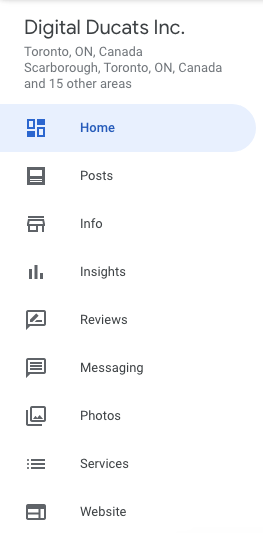
- Find the box that says Get more reviews
Click on the button that says Share review form

- Copy the link generated with your short URL
If you haven’t created a short URL you may be prompted to do so before getting your link to review your business on Google.
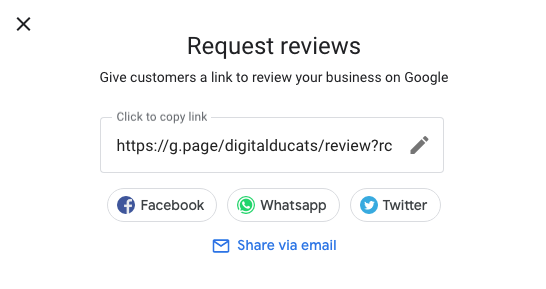
Respond to each type of review
Think of reviews as additional ways to promote your business. Reviews are simply another way that people can learn about your business. Build. your brand and your reputation by responding to as many reviews as possible.
Reviews are a powerful marketing tool that highly influence purchase decisions. Make the most of them by putting your best foot forward for future clients and customer loyalty.
Treat negative reviews as marketing opportunities
It’s imperative to respond quickly to negative reviews. It’s bound to happen from time to time that someone will not get what he or she wanted from your product or service.
Never ignore a negative review as it is best remedied by a timely response.
Responding to a negative review will give you an opportunity to show people how you deal with an unsatisfied customer.
You can take the venom out of a bad review, by stating your side of the story and offering a solution (or apology if it’s required).
People are much more forgiving of a negative review when they see your side of the incident and how you handle a disgruntled customer.
Show your appreciation for positive reviews
When a client leaves your positive review they are helping your business. Show them appreciation by responding to their review. Not only does this make them feel appreciated but it shows other people that you value their business.
There are some people who might feel they should be thanked when they leave a positive review for your business. Cater to your existing clients to promote customer loyalty and keep them coming back time and time again.
Things to avoid when collecting reviews
There are a few guidelines that Google has specifically stated for how you go about asking for reviews. If there is a violation of those guidelines, your reviews may be ignored or your profile suspended.
Never set up a review station to get more Google reviews
Setting up a station for reviews is strictly prohibited. If you are accumulating reviews from the same IP address there is a good chance that Google will begin to ignore reviews that originate from the same IP address.
Never mass email clients to leave a review
Reviews are one of the few things in SEO that you can take your time building. Google expects reviews to trickle in naturally. Any spikes in the number of reviews that you receive will raise suspicion and may result in those reviews being ignored.
Never pay a service to review your company
There are companies that offer services to increase the number of reviews you have on your business. Your reviews should be directly from your clients for an accurate representation of your company.
Never offer incentives to review your company
If a client leaves a review of your business it should be for the right reasons. An incentive creates false reviews since clients are writing the review for the wrong reasons.
Learn more about local SEO services and how your business can benefit.
Create A Custom SEO Strategy For Long-term Growth
Establishing an effective, custom SEO strategy for your business is more important now than it ever has been. The global pandemic has created a strong awareness of the options that exist to people in a contactless environment.
Many people will continue to explore those options long after the pandemic is over. As online searches continue to surge, companies are experiencing a large increase in the demand for their products.
The benefits of SEO have never been greater. A top-ranking in the search results for important keywords can contribute to the largest source of leads and new clients your business acquires.
Many companies relying on the in-store experience have felt the impact, while those positioned at the top of the search results have experienced a boost in brand recognition and overall sales.
The bottom line is that your business needs to be prepared for more digital solutions in a contactless environment. A custom SEO strategy is one of your best solutions to ensuring long-term growth.
Why is SEO important in 2020?
Despite the inevitable end of a global pandemic, the behavioural patterns of the typical consumer has been changed forever. Online searches have surged creating massive traffic opportunities for companies to capitalize on to increase revenue.
So many have turned to online shopping for the first time. As people become more accustomed to researching and making purchases online the trend in online sales will continue to skyrocket.
Ecommerce is booming and will continue its rapid expansion of total sales. The numbers this year will break all records and extend past initial projections.
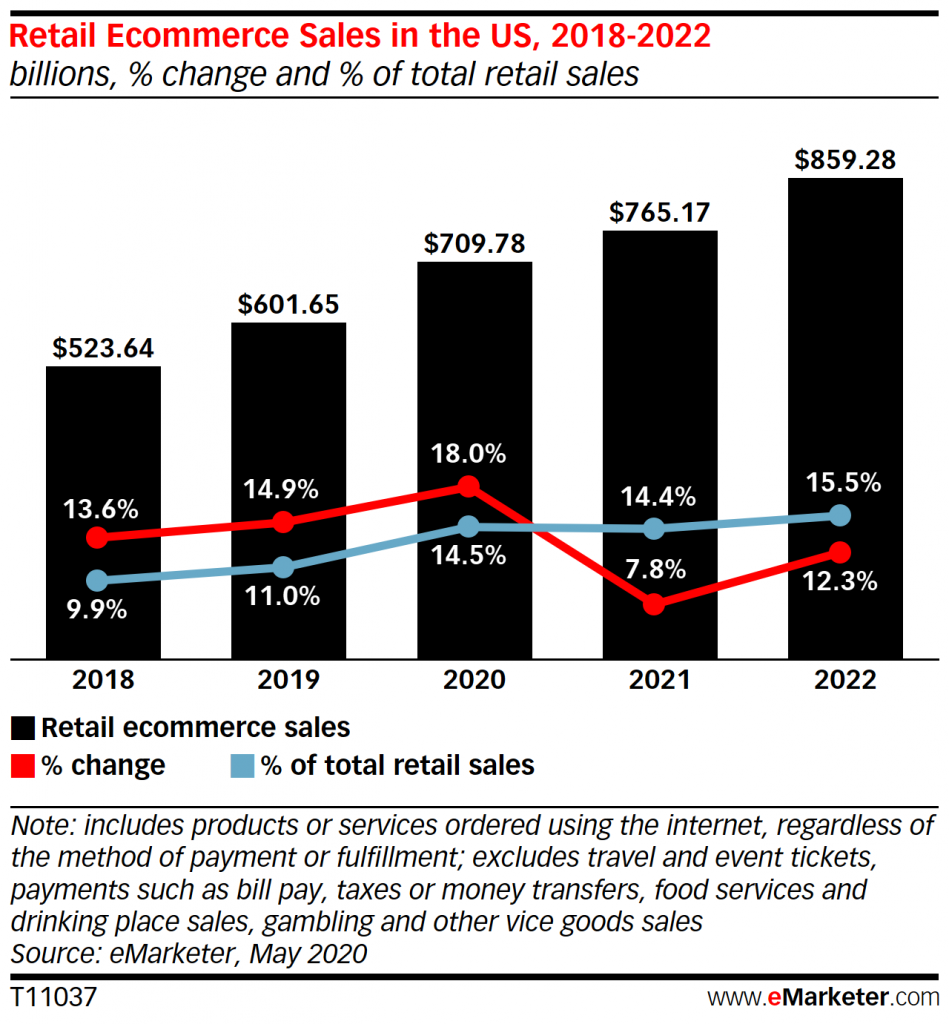
How can you position your company to benefit from the inevitable shift in the way we do business?
Position your website to receive increased search traffic to capture more leads and new clients. Execute a custom SEO campaign designed to drive traffic from keywords that are important to your business.
What is an SEO campaign?
An SEO campaign is a process that improves your website’s search visibility through improved rankings in keyword searches. It results in attracting visitors who are a match to what your business offers in products and services.
An SEO campaign provides the blueprint for developing your site in the major keyword topics that surround the inner workings of your business. As you build content that answers questions and educates visitors, your site becomes increasingly relevant to keyword searches.
As a result, your website appears in keyword-related searches from users at different stages of the buyer journey.
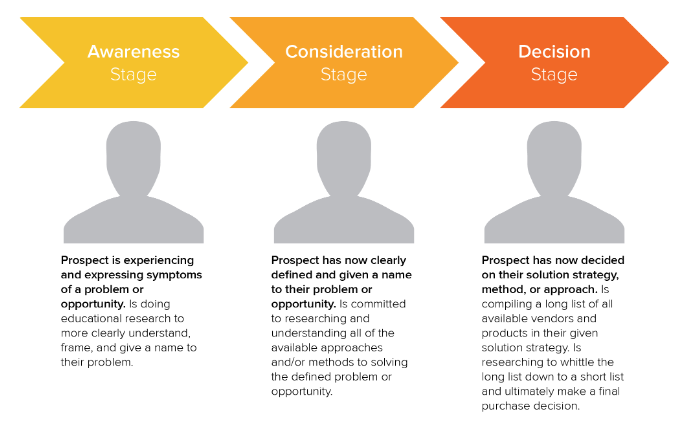
The goal is to create a website that has the ability to drive traffic, educate prospects and convert visitors to clients.
How to customize your SEO strategy and build an effective SEO campaign
The main focus of an SEO campaign is on the keywords you target and the content you publish. The largest ranking factor is being the best result to a search query. An SEO campaign builds the relevance of your page to the keyword topics and targets.
Understand your audience by researching your target keyword
Establishing search intent is crucial to understanding what it is that Google is using to rank pages highly in a search result. Keyword research is the first area that establishes the foundation of an effective SEO strategy.
What is the user truly expecting to find when they type in a search query?
Whenever you’re considering a keyword to target, the first action is to use that keyword in a search. The SERP (search engine result page) contains a lot of information that will point to what is needed to rank for the search term.
Reverse engineer the way other pages have achieved a top ranking to provide clues on how your site will outperform your competition.
Perform a SERP analysis
For every keyword search you will find the following on the SERP:
- The level of competition that competes for the first page
- The type of content that is being used to rank
- How pages are optimized to perform
- How many links are pointing to the ranking pages
- How Google displays the search result
- The commercial value of the search term
Establish intent
The first assessment is whether this term is a perfect fit for your company. If the pages that rank are all competitors that are offering the same product or service it confirms the relevance of the keyword to your business.
If there is a mix of results, consider a more specific search term to avoid unwanted traffic that wouldn’t be interested in your content.
Assess the competition
Using software and keyword tools becomes necessary in order to establish the authority competing pages have built. By identifying the number of links each page has pointing to it, where those links came from and whether they will benefit your site is the first indication of how realistic your keyword is to rank.
Build a list of alternative keywords
A search result can display many different features that are clues to what users are searching for when they search for your keyword. Establish commonly used phrases and keyword alternatives to build a better understanding of what the bigger picture is to the user’s true intent.
Read more on how to choose the perfect keywords for your site
Prioritize your target keywords
Keyword research will result in a large list of keywords, keyword synonyms and related search phrases. Prioritize your list in order of importance. Group your keywords based on search intent.
The result should be a keyword strategy that addresses the most important aspects of your keyword topic. This is the initial blueprint of a keyword strategy that lays the foundation for your content strategy.
Develop your Content Strategy
The approach you take on building content should be to provide as much information about your business by building a resource of information. The content you publish should answer common questions, provide insight and educate based on satisfying the intent of the keywords you target.
As your site becomes more successful in ranking for these terms, it increases the trust search engines place on your website for keyword related searches.
Map your content to match your keyword strategy
A visual representation of a keyword strategy is known as a topic cluster. Google ranks pages based on topical relevance. Connecting the ideas and concepts of your main keyword topic builds more relevance to your site and to the pages that are interlinked.

The pillar pages of your site will target the most important keywords. The clustered content will target more specific searches that serve connect visitors to your business by addressing the various details surrounding your keyword topic.
Read about how to implement pillar pages
Publish content that performs
The content you publish needs to serve the user’s purpose. If there are massive guides that are published on the first page of results for your keyword, it indicates the level of detail that’s required.
The Skyscraper method is a common approach to making sure your content is 10 times better than anything that ranks.
Using this approach ensures you cover the topics and subtopics necessary to address the intent of a search.
Read about how to write SEO content that ranks highly
As a local business, publishing local SEO content is a strategy that enhances your local search appearance.
Optimize for traffic opportunities
When your page ranks at the top of a result, it ranks for a number of different keywords. People use a number of different terms in a search-even though they are searching for the same content. Part of your content strategy includes optimizing for additional terms as well as traffic opportunities that exist in Google features.
Featured snippets and PAA boxes, for example, are considered and traffic opportunities because they are features that attract a percentage of clicks on the search engine result page.
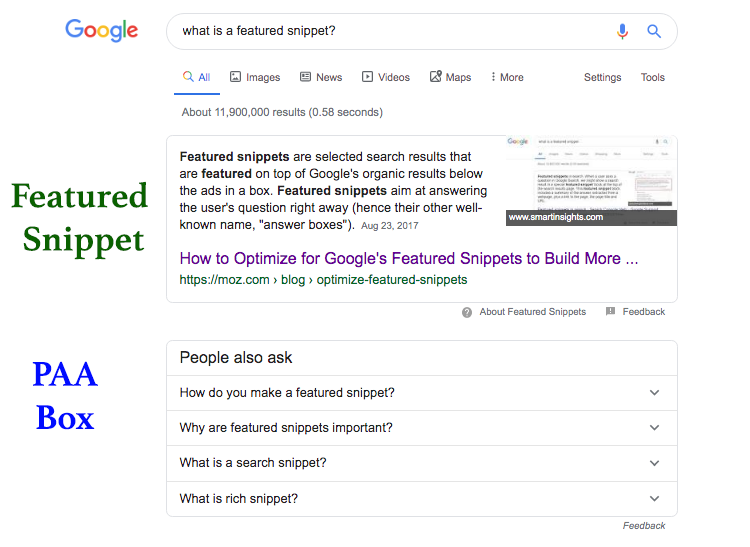
Optimize to appear in these features for additional traffic to the same page for multiple related search terms.
Link building strategy
Link building is necessary to get votes of confidence in the quality of your content. Well-placed links to your content build credibility and authority in your niche and industry.
There are a number of different link building methods you can employ, but regardless of what you choose the strategy should appear as natural as possible.
A common tactic employed is to assess your competitor’s links. By identifying where their links come from, you can pick up on a few links for your site.
Not every link on a competing page will be good for your ranking. In fact, there may be links pointing to their site that don’t help them and are hurting their ranking potential.
Choose to pursue links from websites that have traffic and whose visitors will be genuinely interested in your content. This approach helps to identify the sites that have a strong relation to yours and also get more people on your site that has a strong possibility to become clients.
Reach out to similar niche and authority sites
Most SEO campaigns require some level of outreach. In order to get links in the most natural way, it’s common to reach out to website owners who publish similar content.
The success of your link building depends largely on the quality of your content. When you have good content worth sharing people won’t mind linking to it.
Achieve goals and benchmark your success with your SEO strategy
Every SEO campaign should end with the goal of driving traffic to your site from keyword searches that serve a role in your overall keyword strategy.
Creating content that ranks is a primary function of traffic generation. With the right keyword strategy, your website will thrive from the flow of visitors that convert to clients.
Customize your SEO campaign to achieve keyword related goals and drive traffic that converts.
The Benefits of SEO: The Gift That Keeps On Giving
Search engine optimization is one of the top choices for business owners who are interested in the growth of their company. The benefits of SEO are quite numerous however the reality is that this online marketing strategy has become more of a necessity than a luxury.
The number of companies that actively invest in SEO is growing. In fact, 61% of businesses have stated that SEO will have a place in their budget in 2020 (up from 44% in 2018). With more companies investing in SEO, the leaders will keep leading and putting distance behind those who aren’t following suit.
SEO isn’t a quick process and with most SEO companies you have to pay before you play. At the end of the day, the benefits will far outweigh the cost as the process is essentially adding value to your website on a regular basis.
Here is an infographic on how the process works.
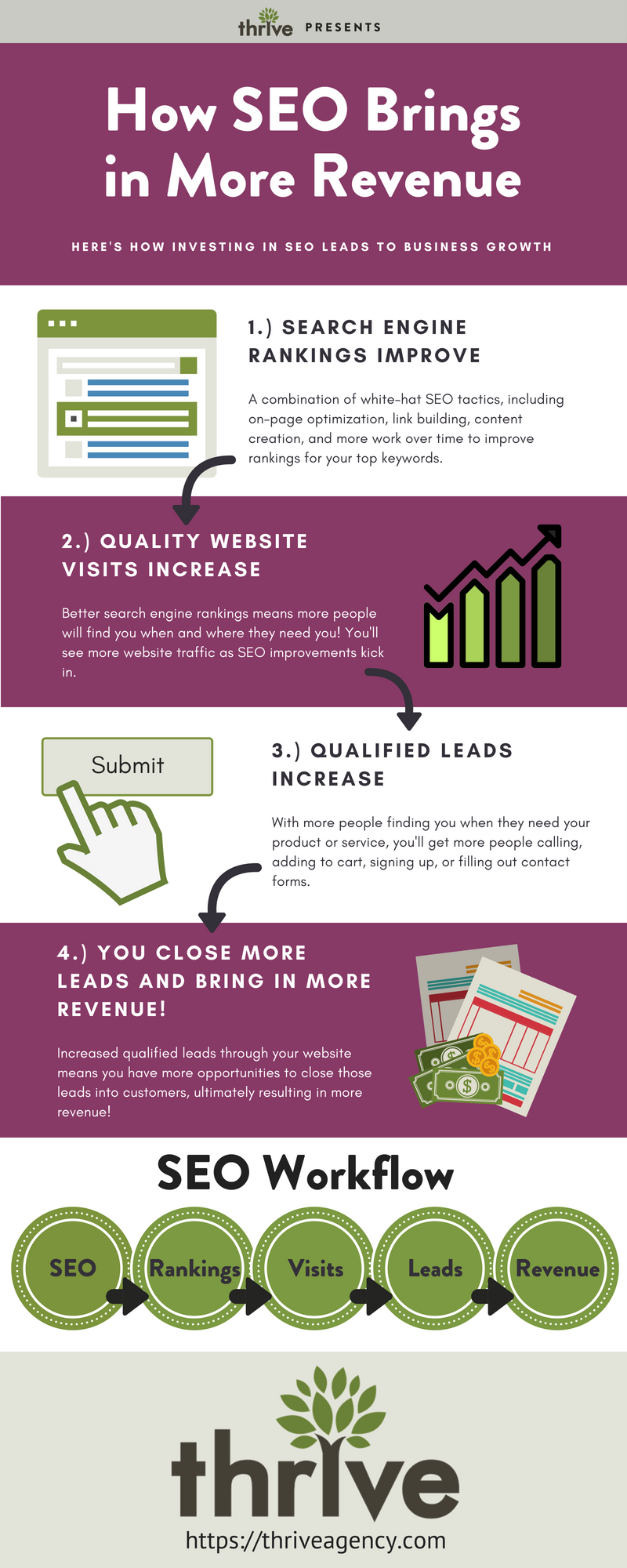
Here are a few benefits of SEO that will put your mind at ease when you make that inevitable decision to invest in the future of your company.
#1-Increased traffic to your website
In order to drive traffic to your website, your pages need to rank highly. It also helps to have a lot of relevant backlinks that can send your site traffic from relevant sources.
There should be no doubt anymore that search engine optimization is a necessary function for competing in the search results. Google recommends that website owners seek the help of an SEO professional to ensure the correct development of a website.
Implementing a custom SEO strategy will target your audience, optimize your content to get a higher ranking and drive more traffic.
#2-Increased development in your niche
A great deal of SEO is publishing content about the major topics and subtopics of your website or company. The process for publishing SEO optimized blog posts identifies areas in which users are showing interest. By addressing the most commonly searched problems by providing solutions, you develop your website to be a major resource in your niche.
As you build on the quality and quantity of content assets on your site it triggers more appearances in the search results for keyword related queries. This drives more relevant traffic that converts at a higher rate.
#3-Brand recognition
Most people prefer to buy from a brand they trust and recognize. Search engine optimization creates more keyword appearances for search terms that are related to your niche. The more a user comes across your website while doing their research, the more likely they are to trust your company.
#4-More new clients
The domino effect is in play when you increase rankings for important keywords to your business. The higher your page ranks, the more traffic is generated. Increase the number of visitors on your site and that results in more leads and new clients.
#5-Reach a targeted audience
One of the biggest aspects of creating SEO content is keyword research. A consultant goes through a series of routine checks to make sure a keyword will drive the right traffic. During the process, many related search terms and topics become apparent and thus become included in the strategy for optimizing a page for a keyword topic.
#6-Higher user engagement
If you’ve done your research correctly, your pages should contain all of the topics that a user is looking for when they search for your keyword. Competitive analysis of the ranking pages will identify what content or multimedia is working best to hold the audience’s attention.
#7-More leads on a consistent basis
The primary reason to optimize your website is to drive more traffic that is interested in what you’re offering. As you develop more content that is specifically for users on each stage of the buyer journey, your site becomes more capable of converting visitors along their journey. The results are more leads on a regular basis.
#8-Improves site structure
The structure of your website plays a role is the experience your users have-which, in turn, sends ranking signals to search engines. It’s important to have a site that allows a user to navigate easily from wherever they are on your website.
When a site is organized by topic, it makes things easier for users to experience more depth within your topic. The organizational structure referred to as topic clusters contribute to higher rankings for a specific keyword topic.
#9-Blueprint for growth
An SEO campaign will target a specific keyword and develop a page or multiple pages around that topic. A great deal of research goes into identifying the best keywords to fit the website’s strategy.
One of the greatest benefits of SEO is having a plan in place for driving traffic. When your company has an established blueprint for achieving specific goals, success can be measured, adjusted and accelerated.
#10-Increased revenue
New leads, new clients and increased revenue all fit into the same overarching goal. The whole point in investing money into your website is to make more money from the increased traffic.
One of the benefits of SEO is the fact it provides one of the best ROI’s in the marketing industry. What could be better being found by users who are actually looking for what you offer?
Conversions are higher than those of paid advertising. However, unlike PPC campaigns, when you stop paying for SEO services, your site continues to drive traffic, leads and new clients to your business.
#11-Alternate stream of income
For companies whose sales have traditionally been in person, SEO can offer an alternate stream of income once they make products available for purchase on-site.
This additional revenue can overcome the inconvenience of distance for many potential clients. This can open up entirely new markets that would have otherwise been unattainable.
#12-Contactless service
Selling products online allows companies to continue making sales; even while regular store hours are closed. A website that ranks for transactional keywords can make money 24 hours a day, 7 days a week.
Ecommerce is a quarantine-proof business if your products are also quarantine-proof. Another one of the benefits of SEO is that it connects customers and vendors despite any types of restrictions or limitations placed on physical interactions.
#13-Reach a larger audience
Search engine optimization allows your business to expand your audience. There are no physical limits. As long as your products or services are consumable by a global audience, the world is at your fingertips.
#14-Improve your online presence
When your company, brand or any keyword related search is made, you want your website to come up in the search results. Improve your online presence for anything related to your niche through a variety of platforms and practices. Options include but are not limited to content marketing, guest posting on high authority sites, expanding your social network, starting a YouTube channel.
#15-Enhance your local presence
As a local business, you want your neighbourhood to know about your company and think of your business when they need something you offer. Local SEO is all about improving your search visibility for localized searches of your products and services.
At least half of all searches made on Google are to obtain information on a local business. Local SEO in Toronto contributes to as much as 80% of businesses total revenue. This is one aspect of SEO that can’t be ignored by companies that offer local services.
#16-Explore a variety of traffic sources
Search engine optimization gives you the option to explore different sources of traffic. There are different search engines to optimize for, paid ads, local pack ranking, SERP features and social media marketing. YouTube, Amazon and even Facebook and other social sites are considered their own search engines, which gives companies more options for sources of traffic.
#17-Identify technical errors on site
Technical SEO can help your website by making pages accessible. Issues that affect your ranking are page speed, duplicate content and indexing issues. An SEO consultant will catch those problems and correct them before they snowball.
#18-Adapt to changes in the algorithm
Google is constantly updating its algorithm, which makes it impossible to stay at the top of a search result without proper maintenance. It is said the Google updates at least twice daily, with around four major updates a year.
An SEO professional can guide you in the right direction when major updates occur. If your ranking suddenly drops, you have someone to source the issue and get things back in order.
#19-Avoid/reverse search engine penalties
Many business owners will make mistakes that could cost them their website’s entire search visibility. For example, unnatural link building can result in your site’s removal from Google’s index altogether.
Ethical SEO experts are able to navigate around the penalties and filters that Google has set forth that would impede ranking and search visibility. It’s one of the benefits of SEO services provided by a professional. The steps to reverse a penalty are often more complicated than what an inexperienced person should undertake.
#20-Identify opportunities
The search results offer many different traffic opportunities that you can pick up on if you’re looking for them. SEO is the combined effort of a lot of smaller moving parts. Capitalizing on opportunities as they come can result in the top ranking, increased search visibility and a bigger bottom line.

![Local SEO For Small Businesses [2020 Update]](https://digitalducats.com/wp-content/uploads/2020/10/Google-my-business-storefront.png)

